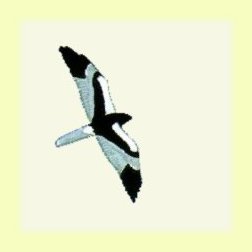Home

Work
Biology...
Programming...
Previous work

Education
A new breeding species for the Philippines: the Pied Harrier (Circus melanoleucos)
Kim van der Linde (1996)
Forktail 11: 172-173 .
 Two harrier species, the Eastern Marsh Harrier Circus spilonotus
and the Pied Harrier Circus melanoleucos , are found in the Philippines
during the winter as migrants (Dickinson et al. 1991). Summer records suggest
breeding, but formal evidence of breeding has not been available (Dickinson 1986; Dickinson
et al. 1991; Danielsen et al. 1994). It has
been reported by Aetas (a local tribe living in the Sierra Madre) to be
a rare breeding bird in cultivated areas in the Dinapique Valley, Palanan,
Isabela (Danielsen et al. 1994).
Two harrier species, the Eastern Marsh Harrier Circus spilonotus
and the Pied Harrier Circus melanoleucos , are found in the Philippines
during the winter as migrants (Dickinson et al. 1991). Summer records suggest
breeding, but formal evidence of breeding has not been available (Dickinson 1986; Dickinson
et al. 1991; Danielsen et al. 1994). It has
been reported by Aetas (a local tribe living in the Sierra Madre) to be
a rare breeding bird in cultivated areas in the Dinapique Valley, Palanan,
Isabela (Danielsen et al. 1994).
During my stay in the Philippines at Isabela State University (ISU) at Cabagan, I was told of juvenile raptors that had been taken from the nest. I visited the "owner" at the beginning of July to see which raptor species he had taken. In a 1 m3 cage was an immature harrier. The bird escaped shortly after my visit, before I could take any photographs. It appeared that it was the only survivor out of three young, and that the nest was located at the Cabagan campus of Isabela State University (ISU), Northern Luzon. The man described the plumage of one of the parents as black and white and that of the other as brownish. The description fits the Pied Harrier, but also the Eastern Marsh Harrier (MacKinnon and Phillipps 1993).
I made my first observations of the species shortly after my arrival at the Cabagan campus, on June 26, 1992. A pair of Pied Harriers was gliding over the wet rice fields along the entrance way. There was already a record of this species from earlier that year, made by a group of Danish ornithologists (A. Jensen, unpublished). The pair remained here until at least January 1993. A pair of Pied Harriers (possibly the same) was still present when I visited the site for a second time, from July 15 till November 1, 1994. A juvenile was seen at the end of October, together with the adult pair, but this juvenile may have been a migrant.
Pied harriers, like harriers in general, prefer open
habitats such as (grassy) marshes, reed beds, and rice fields (MacKinnon
and Phillipps 1993). Open habitats like grassland and wet rice fields are
the dominating habitats on the ISU campus terrain and the surrounding areas.
The nest was found in the newly established forest plantation at the east
side of the campus.
Once, the Philippines were mainly covered with tropical
rainforest. Now only a small fraction of the forest remains because of
activities such as logging and kaïngin (a form of slash and burn
agriculture).
Grasslands and rice fields are now very extensive, offering a suitable
habitat. The Pied Harrier seems to have taken advantage of this change
by extending its breeding range southward, enriching the fauna of the
Philippines.
Which species will do the same in the future?
References
- Danielsen, F., Balete, D.S., Christensen, T.D., Heegaard, M., Jakobsen, O.F., Jensen, A., Lund, T. and Poulsen, M.K. (1994) Conservation of Biological Diversity in the Sierra Madre Mountains of Isabela and southern Cagayan Province, The Philippines. Manila: DENR-BirdLife International and Copenhagen: DOF.
- Dickinson, E.C. (1986) Does the Pied Harrier Circus melanoleucus breed in the Philippines? Forktail 1: 85- 86.
- Dickinson, E.C., Kennedy, R.S. and Parkes, K.C. (1991) The birds of the Philippines. An annotated checklist. Tring: British Ornithologists Union, c/o Zoological Museum.
- MacKinnon, J. and Phillipps, K. (1993) A Field Guide to the Birds of Borneo, Sumatra, Java and Bali. Oxford: Oxford University Press.